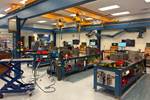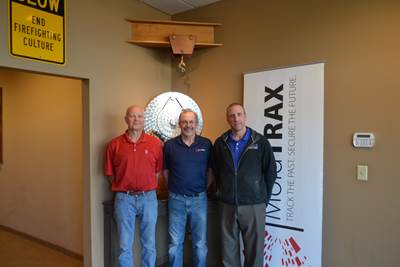What You Need to Know About Hot Runner Systems and How to Optimize Their Performance
How to make the most out of the hot runner design, function and performance.
Hot runner systems involve hot halves/manifolds, nozzles, gates and temperature controllers whose design and maintenance are critical for optimal cycle time, final part quality, long mold life and minimal maintenance. A hot runner maintenance program should involve purchasing, processing and preventive maintenance training. Source (All Images) | MMT
Hands-on learning is without a doubt an effective addition to classroom curricula when it comes to learning about almost anything. To be sure, it is advantageous to those who want to know more about how to care for and optimize the growing number of hot runner systems being used in injection molds everywhere.
Anyone working with these systems understands how complex and critical they are to the successful performance of a mold. There are many factors to consider when it comes to hot runner system maintenance, not the least of which is how to use an ohmmeter — an important tool for measuring electrical resistance in hot runner systems — but here are a few essential considerations from a hot runner maintenance workshop led by MoldTrax in 2019 that still stand today.
-
Injection molding is not simple, and the hot runner system makes it even more complex.
During the workshop, Steve Johnson, MoldTrax’s president at the time, spelled it out. He told attendees that MoldTrax surveyed 12 companies over three years and discovered that the number one mold issue that they deal with, by far, is flash on parts. “The second biggest defect is the hot runner manifold, and breaking it down further, everyone has an encapsulation horror story, but that was not as much of a problem as we expected,” he said. Nevertheless, issues with hot runner manifolds ranks number two!
Johnson also told attendees that raising the “maintenance bar” when caring for hot runner molds means developing a higher skill level through:
- Better documentation.
- More knowledge of hot runner function (seal areas, leak points, valve gate operation and so on, to recognize where the critical areas are and to be better troubleshooters, not just tooling replacers.
- It’s a crime scene! Read the clues, detect the issues.
- Electrical knowledge — understanding insulation and element resistance testing and monitoring, continuity — replace, splice and more.
- Developing the methodology and bench techniques needed to accurately and safely disassemble, clean, inspect and reassemble a manifold system.
- Acquiring the skills and tools to work more closely (precise measuring, smaller tolerances, coordination, patience, focus).
- Having a keener sense of feel for resistance (the head to hand connection).
“You must figure out where the resistance is coming from versus taking the old rawhide hammer and letting her fly,” Johnson said. He recommends a more professional approach, including using the right tool for the job and refraining from quick, cheap fixes.
Once a manifold hits the bench, a toolroom technician should take ohms readings of all thermocouples (T/Cs) and heaters.
Johnson also touched on the lack of skilled technicians, saying that 2.5 million jobs need to be filled today. “Companies are losing business opportunities because they don’t go anywhere near hot runner repair or maintenance or they are sending the work out.” He added that “joystickers” (young adults who are into playing video games) are lacking in mechanical knowledge and they need guidance and training, but they do have a higher comfort level with digital tools, which can be an advantage.
-
Lean on those who know because you can’t understand everything.
Seek knowledgeable minds in hot runner and molding technologies that understand the latest hot runner system technologies, how to make more informed manifold choices, what to know when reviewing hot runner applications and more.
The following are a few tips and takeaways from presentations by DME, Husky, Mold-Masters, Synventive and Yudo. These are intended to be “food for thought” when addressing hot runner designs and challenges:
- You can have a beautifully constructed manifold and great material, but
if your nozzle wells and your tips do not interact the same way, you are going to have relative shear differences. Your cavities are not going to fill properly.
- Flash is primarily caused by heat, pressure or tool damage. If a flash condition exists with little to no hold pressure applied, inspect the mold for damage.
- Sink can be caused by heat, underpacking or overpacking a part. It is often attributed to a part design issue as well.
- Burns (indicated by streaks or color swirl) and trapped gas are generally related to poor venting conditions or to shear heat that is created by filling cavities too quickly.
- Cascade filling can lead to sudden flow-front accelerations and stagnations, causing defects, including halos, witness lines, blemishes and others.
- Hot runner cable upkeep is paramount to proper setup. Cables should be inspected every change for crimps and plug wear/breakage. Repair or replace damaged plugs and wiring to prevent their use in setup events. This will help to avoid downtime.
- Marrying the hot runner controller to the molding press is highly recommended because two identical units can perform differently. So, for the sake of process repeatability, it is best to use the same controller every time.
- Precise temperature control means no more than a 1°F variation.
- Cleanliness is the biggest reason why hot runner technology is moving to servo/electrification, but it also enables more precision, better efficiencies and more reliable operation.
- Networking (connectivity, as in Industry 4.0) is something that our industry is way behind on, but it is coming.
- Few people calibrate their temperature controllers, but they should.
- Using a temperature controller as a diagnostic tool can save time and make root cause troubleshooting much easier.
-
Collect, analyze and use data to make decisions that will improve mold and part quality and performance.
While this is good advice for overall mold maintenance and repair, it was also emphasized by various speakers during the hot runner conference. Rich Oles of Alba Enterprises said, “Assume nothing, check everything. Assess the issue and validate everything — everything that you are going to use as a basis, it is your responsibility to go down to the baseline and get everything documented. Develop a logical thought process on the ‘why’ with a foundation based on what could be causing it in order to determine a goal for fixing what’s wrong. A shotgun approach to fixing any issues is not the right approach if you want to sustain the effects of the solution and keep that mold running optimally.”
“Documentation of a mold’s production and maintenance history is so important,” Johnson added. “Every bench should have a docking station for a computer to make the documentation process more convenient and quicker. If you want tradesmen to use data, you better make it easy for them.”
Johnson has contributed many informative features for MMT over the years, and many of these address the importance of documentation and proactive mold maintenance best practices. To read more about how and why he believes it is so critical (one reason is because it can save companies a lot of money), you can find his columns (older and newer — all relevant) primarily under Across the Bench and under Maintenance Matters.
-
An understanding of velocity and the viscosity curve is vital to improving the mold design, molding process and final part.
In addition to Oles, processing guru John Bozzelli and Bill Hartwick of Filter Specialties Inc. also spoke, providing relevant insights into scientific molding as it pertains to hot runner systems and their design, walking attendees through the “pellet to part” process and noting important aspects that influence the success or failure of part production.
Specifically, Oles, Bozzelli and Harwick addressed the fundamentals of troubleshooting melt delivery systems, whether a hot runner or cold runner. Oles began by saying that any time he presents at an event like this, attendees are curious and want to know what the best temperature settings for optimum melt delivery are. “I tell them that every case is unique. Each application has a different volume, a different part geometry, a different press and screw configuration, different valve size and manifold configuration and so on. All of these things contribute to the end result,” he said. “If you try to pull one part or aspect out of the equation and make it standard, you will fail.”
Oles went on to explain that plastic is a non-Newtonian fluid, meaning that its viscosity changes during the injection molding process. What is viscosity? It is the plastic’s resistance to flow. High viscosity means the plastic flows like honey, very slowly; while low-viscosity plastic flows freely, almost like water. Additionally, shear is the change in viscosity that happens when one layer of polymer slides against another layer of polymer. Shear rate is determined by the volume of plastic that is flowing through a fixed vessel (the melt delivery system). The higher the shear rate, the lower the plastic material’s viscosity becomes. Heat, and how it is applied, directly affects viscosity and the overall melt condition of the plastic.
“You have to understand how plastic behaves,” Bozzelli said, referring to a graph showing a typical velocity curve. “This curve starts out very, very stiff, and as you get it to flow, the faster you go, the more the molecules line up and the easier it flows. Thi is counterintuitive, but plastic is kinder and gentler, filling the mold reasonably fast.” This is especially important when one is dealing with a multi-cavity mold, he said, because viscosity from one cavity to another can be very different, as can the pack and hold stage in each cavity. “Make sure you do a proper investigation for every mold, and if at all possible, conduct a head-to-head same mold comparison with someone who truly knows scientific molding and knows how to process.”
“How many times have you been at a machine and said, ‘This is my problem,’ and stopped looking for any other possible causes?” Oles added. “Consider what John just said and avoid evaluating on bogus data.”
If you have a well-established and validated process, you can assess new technology based on that process. However, without understanding what you are evaluating or collecting data and measurements over time, including ohm ratings, you may encounter difficulties in production.
Related Content
5 Hot Runner Tips for Moldmakers and Molders
Best practices for initial hot runner tryouts and effective preventive maintenance.
Read MoreWhat Is Scientific Maintenance? Part 1
Part one of this three-part series explains how to create a scientific maintenance plan based on a toolroom’s current data collection and usage.
Read MorePortable Low-Heat, Non-Arcing Resistance Welder for Mold Repair
Rocklin’s user-friendly MoldMender Micro Welder delivers simple and cost-effective localized repair in-house with precision and versatility, enhancing mold and die durability and reducing disassembly and downtime.
Read MoreLaser Welding Versus Micro Welding
The latest battle in finely detailed restoration/repair of mold materials.
Read MoreRead Next
Mold Maintenance Training Courses Teach Mold Management, Upkeep
Five comprehensive courses are available through Beaumont’s AIM Institute, which is also creating a new Mold Maintenance Center of Excellence in 2024 for additional education and training opportunities.
Read MoreMold Maintenance Continues to Matter: Enhanced Training Program in a New Facility
I attended a MoldTrax mold maintenance workshop in 2019 and shared my experiences, and despite changes in ownership, the workshop's remarkable value endures, as discussed in a recent Q&A with the current leadership.
Read MoreAIM Institute Deepens Mold Maintenance Training Course Learning
Acquisition of specialized equipment used in conjunction with MoldTrax mold maintenance training courses adds to AIM’s virtual and in-person course curriculum for the injection molding industry.
Read More.jpg;maxWidth=970;quality=90)


















.jpg;maxWidth=300;quality=90)







